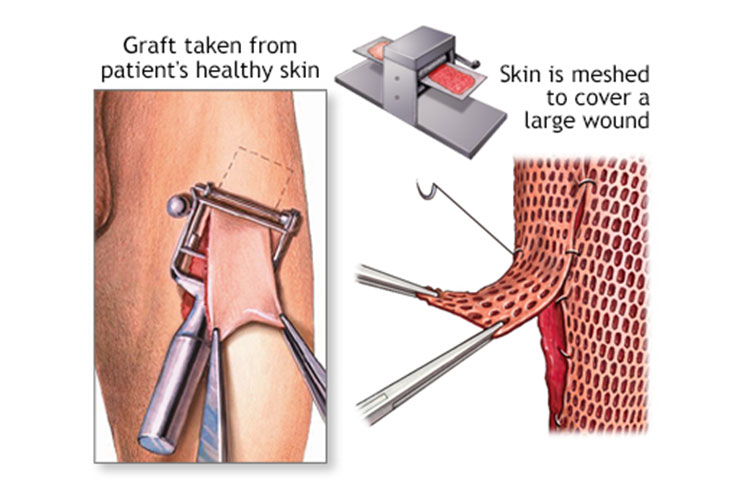Skin grafting is a surgical procedure used to treat various skin conditions, injuries, or defects by transplanting healthy skin from one area of the body, called the donor site, to another area where skin has been damaged or lost, known as the recipient site. This procedure can help promote wound healing, improve cosmetic appearance, and provide functional reconstruction. Here’s an overview of skin grafting:
Types of Skin Grafts:
- Autograft: An autograft is the most common type of skin graft and involves using the patient’s own skin as the donor tissue. The donor site is usually selected based on factors like skin quality and the availability of excess skin. Common donor sites include the thigh, buttock, or upper arm.
- Allograft (Homograft): Allografts involve using skin from another human donor, typically from a tissue bank. These grafts are temporary and are often used as a temporary covering for large wounds while the recipient site heals or in cases of severe burns.
- Xenograft (Heterograft): Xenografts use skin from animals, usually pigs. These grafts are also temporary and are primarily used in situations where human donor or synthetic graft options are limited.
Procedure Steps:
The skin grafting procedure generally follows these steps:
- Preparation: The surgeon assesses the recipient site and donor site. The recipient site may need to be prepared by removing any dead or damaged tissue to create a healthy wound bed.
- Donor Site Selection: If an autograft is used, the surgeon selects a donor site with skin that closely matches the color, texture, and thickness of the recipient site.
- Donor Tissue Harvesting: The surgeon carefully removes the donor skin, often using a dermatome (a surgical instrument) to create thin, uniform slices of skin. These slices are then trimmed to the appropriate size and shape.
- Recipient Site Preparation: The recipient site is made ready to receive the graft. This may involve cleaning, debriding, or excising damaged tissue to create a healthy wound bed.
- Graft Placement: The harvested skin graft is carefully placed onto the recipient site. The surgeon ensures that it is secured in place and has good contact with the wound bed. Sutures, staples, or adhesive may be used to secure the graft.
- Dressings: Dressings are applied over the graft to protect it and facilitate healing. Some grafts may require a bolster dressing or a tie-over dressing to maintain graft-to-wound contact.
- Healing and Monitoring: The graft is monitored closely in the days and weeks following the procedure to ensure it “takes” or becomes integrated with the recipient site. The dressings are typically changed regularly, and the patient is observed for signs of graft rejection or infection.
Recovery and Outcomes:
Recovery from a skin grafting procedure varies depending on the size and location of the graft. In general, patients can expect some pain and discomfort initially. The graft site will gradually heal over several weeks to months, and scarring is often a concern, especially with autografts. Over time, the appearance of the graft site may improve, and additional cosmetic procedures can sometimes be considered to further enhance the result.
Skin grafting is a valuable surgical technique used for various medical conditions, including burns, chronic wounds, traumatic injuries, and reconstructive surgery. The choice of graft type and surgical technique depends on the specific circumstances and the patient’s overall health and goals.

